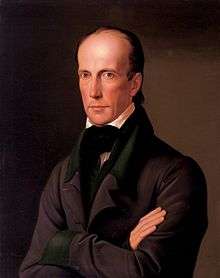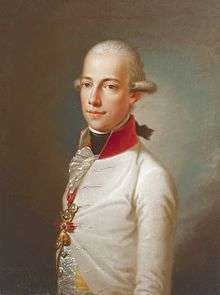Archduke John of Austria
| Archduke John | |
|---|---|
 Portrait by Leopold Kupelwieser, 1828 | |
| Imperial regent | |
| In office | 12 July 1848 – 20 December 1849 |
| Predecessor | Ferdinand I of Austria (President of the German Confederation) |
| Successor | Francis Joseph I of Austria (President of the German Confederation) |
| Born |
20 January 1782 Florence, Grand Duchy of Tuscany |
| Died |
11 May 1859 (aged 77) Graz, Styria, Austrian Empire |
| Burial | Schenna Castle, Tyrol |
| Spouse | Anna Maria Josephine Plochl |
| Issue | Franz, Count of Meran |
| House | House of Habsburg-Lorraine |
| Father | Leopold II, Holy Roman Emperor |
| Mother | Maria Luisa of Spain |
Archduke John of Austria (German: Erzherzog Johann Baptist Joseph Fabian Sebastian von Österreich; 20 January 1782 – 11 May 1859), a member of the House of Habsburg-Lorraine, was an Austrian field marshal and Imperial regent (Reichsverweser) of the emerging German Empire during the Revolutions of 1848.
Biography
John was born in Florence, the thirteenth child of the Habsburg grand duke Leopold of Tuscany and Maria Louisa of Spain. He was baptized with the name of John Baptist Joseph Fabian Sebastian,[1] after the patron saint of the Tuscan capital. In 1790, Leopold succeeded his brother Joseph II as Holy Roman Emperor and his family moved from the Grand Duchy of Tuscany to the Imperial court in Vienna. Only two years later, John's elder brother Francis II ascended the Imperial throne.

John's native language was Italian, he learned to speak French and German fluently. Educated by the Swiss historian Johannes von Müller, he developed wide-ranging skills and interests, especially in the history and geography of the Alpine countries.
Military service
During the Napoleonic Wars, John was given command of the Austrian army in September 1800, despite his personal reluctance to assume the position. He showed personal bravery in the War of the Second Coalition, but his troops were crushed at the Battle of Hohenlinden on 3 December. Demoralized by defeat, the army nearly disintegrated in the subsequent retreat, which was only stopped by an armistice arranged on 22 December. After the Peace of Lunéville in 1801, Archduke John was made General Director of the Engineering and Fortification Service, and later commander of the Theresian Military Academy in Wiener Neustadt.
In the War of the Third Coalition, John again fought the French and Bavarian forces. From 1805 he directed an able defence of several Tyrolean passes against the French and was awarded the Commander Cross of the Military Order of Maria Theresa. However, according to the Peace of Pressburg, Austria had to cede Tyrol and Vorarlberg to Bavaria. John remained obliged to Tyrol and maintained friendly contact with Baron Joseph Hormayr who forged a resistance movement against the Bavarian occupation. In 1808, John pressed for the creation of Tyrolean Landwehr forces based on the success of the Prussian Landwehr, which played a vital role in the Tyrolean Rebellion led by Andreas Hofer.
At the commencement of the War of the Fifth Coalition in 1809 he became commander of the Army of Inner Austria, fighting against the French forces of Eugène de Beauharnais in Italy. Under his command were the VIII Armeekorps led by Albert Gyulai and the IX Armeekorps headed by Albert's brother Ignaz Gyulai. After winning a significant victory at the Battle of Sacile on 16 April 1809, his army advanced almost to Verona. Having detached forces to besiege Venice and other fortresses, John's army was soon outnumbered by Eugène's heavily reinforced host. Worse, news of the Austrian defeat at the Battle of Eckmühl reached him and compelled him to order a retreat. Before withdrawing, he fought off Franco-Italian attacks at the Battle of Caldiero between 27 and 30 April. Attempting to blunt the Franco-Italian pursuit, he stood to fight on 8 May and was beaten at the Battle of Piave River. Trying to defend the entire border, he sent Ignaz Gyulai to defend Ljubljana (Laibach) in Carniola, while holding Villach in Carinthia with his own forces. Eugène's pursuit overran the frontier defenses at the Battle of Tarvis and wrecked a column of hoped-for reinforcements at the Battle of Sankt Michael. Forced to flee northeast into Hungary, John offered battle again but was defeated at Raab on 14 June 1809. Ordered to join his brother Archduke Charles at the Battle of Wagram on 5 and 6 July, John's small army arrived too late to avert an Austrian defeat. His brother criticized him for tardiness.
After the conclusion of the campaign, John again evolved plans for a widespread rebellion. However, upon the Treaty of Schönbrunn Austrian policies under Minister Klemens von Metternich sought a rapprochement to France. John's friend Baron Hormayr and other conspirators were arrested, the archduke himself effectively was sidelined and retired to his estates in Thernberg.
Post military



John, tired of warfare, turned away from the military and developed a great interest for nature, technology and agriculture. He collected minerals and was active as an alpinist and hunter in the Duchy of Styria. In his early days Archduke Johann and his brother Louis had the habit of travelling to France, where the latter married Madame de Gueroust. In 1815, on his visit to the United Kingdom, John received a Doctor honoris causa degree from the University of Edinburgh.[1]
In the history of Styria, he is remembered as a great modernizer and became an important figure of identification for Styrians. His proximity to the people is given evidence to by his many contacts with the common man, by wearing the local Tracht, the Steireranzug, and by collecting and promoting the material and spiritual culture of the country. In 1811, he founded the Joanneum Museum in Graz and the predecessor of Graz University of Technology. Some other foundations were initiated by him, such as the Styrian State Archive 1817, the Berg- und Hüttenmännische Lehranstalt, which was founded in 1840 in Vordernberg and became the University of Leoben in 1849, the Styrian Society for Agriculture 1819, the Mutual Fire Insurance, the Styrian Building Society, the Landesoberrealschule in 1845 and the Society for Styrian History in 1850. His routing of the Austrian Southern Railway from Vienna to Triest over the Semmering Pass and through the Mura and Mürz valleys to Graz is particularly notable. The inheritance of his maternal uncle Duke Albert Casimir of Teschen enabled him to acquire a tin factory in Krems near Voitsberg and coal mines near Köflach, thereby he also became an industrialist. In 1840, he bought the Stainz dominion, where he was also freely elected as mayor in 1850. He was already the lord of the Brandhof manor in Mariazell.
In 1829, he married Anna Plochl (1804-1885), the daughter of Jakob Plochl, postmaster of Aussee, and his wife Maria Anna Pilz, during a nocturnal ceremony in Brandhof. By this morganatic marriage, John was excluded from succession to the throne. Emperor Francis elevated Anna to a "Baroness of Brandhofen" in 1834 and in 1839 she gave birth to a son, Franz, the only child from the marriage. His descendants were styled "Counts of Meran" and "Barons of Brandhofen", Proprietors of Stainz and Brandhofen.
John was also a passionate mountaineer in the Eastern Alps and attempted to be the first to climb the Großvenediger. For that reason, the Erzherzog-Johann-Hütte (Adlersruhe) at the Grossglockner, and the Archduke John's Vanilla Orchid (Nigritella rubra subsp. archiducis-joannis), an orchid growing on mountain meadows, are named after him.
Imperial regent
Even though Johann did not consider himself a liberal, he promoted some liberal ideas. He was often in conflict with the Habsburg court, especially because of his morganatic marriage, though he never openly rebelled. He had earned great recognition in the Styrian lands, moreover he gained general acceptance by his jovial manners and his marriage with a middle-class woman.
Upon the March Revolution of 1848, the Frankfurt Parliament discussed the appointment of an all-German government replacing the Federal Convention . On a proposal by the liberal politician Heinrich von Gagern, the assembly voted for the establishment of a central authority and on 29 June 1848 elected Archduke John regent of the realm.
As head of state, his political office did not offer many opportunities, though all laws had to be signed by him and he appointed the ministers Anton von Schmerling, Johann Gustav Heckscher and Eduard von Peucker to office, completed by Prince Carl of Leiningen as minister president and head of government. Archduke John did not take part in the draft of the Frankfurt Constitution, which was adopted on 28 March 1849, and pronounced against the strong position of Prussia.
In December 1848 the government headed by Schmerling lost its majority in parliament and Archduke John appointed Heinrich von Gagern minister president. When in April 1849 King Frederick William IV of Prussia openly rejected the Constitution, he remained passive and Gagern handed in his resignation on May 10. John insisted that he would exert central authority, nevertheless after the final failure of the March Revolution, John resigned from his office on 20 December 1849.
Archduke Johann died in 1859 in Graz, where the fountain erected in his honour (illustration) dominates the central square. He is buried in Schenna near Meran. He was the great-grandfather of noted conductor Nikolaus Harnoncourt (1929–2016).
Ancestry
Notes
- 1 2 Schlossar 1878, p. 319.
References
- Schlossar, Anton (1878), Erzherzog Johann von Österreich und sein Einfluß auf das Culturleben der Steiermark (in German), Vienna: Wilhelm Braumüller
External links
| Wikimedia Commons has media related to Archduke Johann of Austria. |
-
 Burlingame, Edward L. (1879). "John (Johann Baptist Joseph ), archduke of Austria". In Ripley, George; Dana, Charles A. The American Cyclopædia.
Burlingame, Edward L. (1879). "John (Johann Baptist Joseph ), archduke of Austria". In Ripley, George; Dana, Charles A. The American Cyclopædia.
-
 "John Baptist Joseph Fabian Sebastian, Archduke of Austria". New International Encyclopedia. 1905.
"John Baptist Joseph Fabian Sebastian, Archduke of Austria". New International Encyclopedia. 1905. - Anton Schlossar (1881), "Johann (Erzherzog von Österreich)", Allgemeine Deutsche Biographie (ADB) (in German), 14, Leipzig: Duncker & Humblot, pp. 281–305

.svg.png)